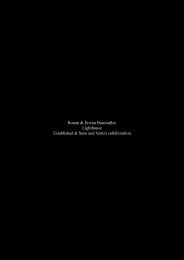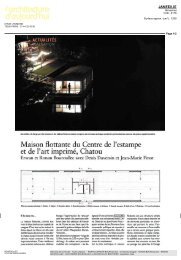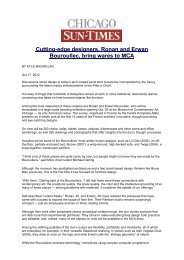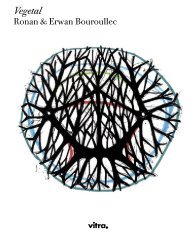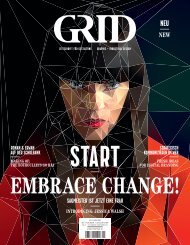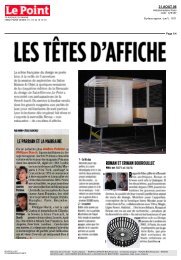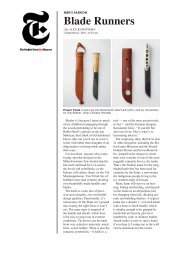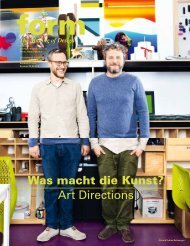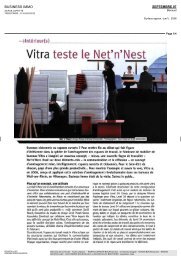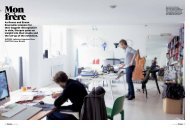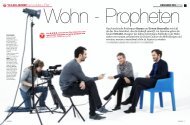Anche gli stampi hanno un'anima - Ronan et Erwan Bouroullec
Anche gli stampi hanno un'anima - Ronan et Erwan Bouroullec
Anche gli stampi hanno un'anima - Ronan et Erwan Bouroullec
You also want an ePaper? Increase the reach of your titles
YUMPU automatically turns print PDFs into web optimized ePapers that Google loves.
Design Anatomy 01<br />
Alessandro Mendini<br />
ci regala un saggio di critica<br />
del design: al centro<br />
della scena, la sedia Veg<strong>et</strong>al<br />
di <strong>Ronan</strong> ed <strong>Erwan</strong><br />
<strong>Bouroullec</strong> per Vitra<br />
<strong>Anche</strong><br />
<strong>gli</strong> <strong>stampi</strong><br />
<strong>hanno</strong><br />
un’anima<br />
Even Moulds Have Souls<br />
An essay in design criticism<br />
by Alessandro Mendini:<br />
centre-stage is<br />
<strong>Ronan</strong> and <strong>Erwan</strong><br />
<strong>Bouroullec</strong>’s<br />
Veg<strong>et</strong>al chair<br />
for Vitra<br />
a cura di / edited by Anniina Koivu e / and Mia Pizzi foto di / photo by Giovanna Silva<br />
52 490 490<br />
53<br />
design<br />
criticism
Alessandro Mendini<br />
(Italia, 1931) archit<strong>et</strong>to, designer,<br />
artista. Protagonista del design<br />
italiano, dalla fine de<strong>gli</strong> anni S<strong>et</strong>tanta<br />
ne è stato suo sensibile interpr<strong>et</strong>e<br />
e teorico radicale. Socio dello studio<br />
Alchimia, è stato dir<strong>et</strong>tore<br />
di Casabella e Domus, ideatore<br />
e dir<strong>et</strong>tore di Modo. Compasso d’Oro<br />
per il design nel 1979 e nel 1981,<br />
dal 1989 coordina a Milano, con il<br />
fratello Francesco, l’Atelier Mendini.<br />
(Italy, 1931) architect, designer, artist.<br />
A leading exponent of Italian design<br />
from the late 1970s, he has been its<br />
most conscientious interpr<strong>et</strong>er and<br />
radical theor<strong>et</strong>ician. A partner at<br />
the Alchimia firm, he has been the<br />
chief editor of Casabella and Domus,<br />
and the designer/editor of Modo.<br />
Compasso d’Oro for design in 1979<br />
and 1981, he has been running – with<br />
his brother Francesco – the Atelier<br />
Mendini in Milan since 1989.<br />
www.ateliermendini.it<br />
Le sedie fatte a immagine della<br />
natura <strong>hanno</strong> una storia lunga,<br />
a iniziare dall’Egitto (e prima).<br />
E poi quelle eccentriche inglesi<br />
e coloniali, e molte altre.<br />
<strong>Anche</strong> ora vari autori<br />
si sono ispirati ai rami, ai liquidi,<br />
ai nidi d’ape per elaborare<br />
le forme, le espressioni,<br />
le strutture e le decorazioni<br />
di sedie, divani e poltrone.<br />
Chairs made to imitate a feature<br />
of nature have a long history,<br />
starting from Ancient Egypt<br />
(and even earlier). Then there are<br />
all those En<strong>gli</strong>sh eccentrics,<br />
innumerable colonial versions,<br />
and many others. Still today, some<br />
designers have been inspired by<br />
branches, liquids and honeycombs<br />
to develop the forms, expressions,<br />
structure and decor of their chairs,<br />
sofas and armchairs.<br />
1 Robby + Francesca Cantarutti,<br />
Forest, Fast (2004); alluminio<br />
verniciato / painted aluminium.<br />
2 Ross Lovegrove, Supernatural,<br />
Moroso (2006); polipropilene<br />
rinforzato con fibra di v<strong>et</strong>ro /<br />
fiberglass-reinforced polypropylene.<br />
A - Critiche, ma in un contesto<br />
di eccellenza<br />
È raro oggi che un designer esponga la teoria di un suo<br />
ogg<strong>et</strong>to, motivandolo a se stesso e alla propria coscienza.<br />
È bello che i fratelli <strong>Bouroullec</strong> abbiano fatto questo, abbiano<br />
espresso il loro pensiero, in occasione della sedia Veg<strong>et</strong>al.<br />
È anche raro e bello che un industriale (Rolf Fehlbaum)<br />
descriva non solo le gioie e i meriti, ma anche i dubbi,<br />
le domande e le ansie di un prog<strong>et</strong>to che lo coinvolge molto.<br />
I loro scritti per la sedia Veg<strong>et</strong>al sono importanti. Ed esemplare<br />
è la documentazione di questa nascita, dal concepimento<br />
al parto, avvenuto dopo quattro anni: una sequenza di<br />
reliquie, m<strong>et</strong>odica, filologica, m<strong>et</strong>icolosa e quasi ossessiva.<br />
Ma anche a me sorgono alcune domande: è altr<strong>et</strong>tanto<br />
esemplare il risultato raggiunto? Esiste dentro questa sedia<br />
l’ossigeno della novità, oppure questo ogg<strong>et</strong>to rischia di essere<br />
inerte e chiuso in se stesso? Si può dire che tanta fatica sia stata<br />
spesa bene? E se questo immane lavoro di equilibrismo fosse<br />
tutto un abba<strong>gli</strong>o, finito in un vicolo cieco?<br />
1 2<br />
A - Criticism, but in a context<br />
of excellence<br />
Nowadays designers rarely express the theory behind their<br />
creations, or discuss the reasons which lie behind their work.<br />
So it’s nice to see the <strong>Bouroullec</strong> brothers doing just that:<br />
expressing their thoughts about their Veg<strong>et</strong>al chair. It’s also rare<br />
– and refreshing – to see an industrialist (Rolf Fehlbaum) talking<br />
about the joys and merits of his production, but also expressing<br />
doubts, questions and problems linked to a design project<br />
with which he was closely involved. What they’ve written about<br />
the Veg<strong>et</strong>al chair is important. The documentation of its four-year<br />
gestation period is exemplary: it is a sequence of relics, m<strong>et</strong>hodical,<br />
philological, and m<strong>et</strong>iculous and at the limit of the obsessive.<br />
But I still find myself asking a number of questions: is the final<br />
result equally exemplary? Is this chair permeated by the power<br />
of the new, or will it end up as som<strong>et</strong>hing inert and closed<br />
in on itself ? Was it really worth all the effort? What if this<br />
incredible balancing act does nothing but dazzle us, without<br />
actually leading anywhere?<br />
VEgEtAl<br />
tempo di sviluppo<br />
development time<br />
2004 - 2008<br />
dimensioni altezza / height 81,3 cm<br />
dimensions larghezza / width 60,6 cm<br />
profondità / depth 55,2 cm<br />
peso<br />
weight<br />
ca. 5 kg<br />
materiale poliamide tinto in massa /<br />
material coloured polyamide<br />
colori basic dark mouve, grigio / grey,<br />
colours mattone / brick, crema / creme,<br />
foresta / forest, castagna / chestnut<br />
prezzo 319 euro<br />
price in vendita da giugno 2009 /<br />
for sale from June 2009<br />
54 490 490<br />
55<br />
foto di / photo by Giovanna Silva
La Bella Addormentata nel bosco,<br />
l’arrivo di Cappucc<strong>et</strong>to Rosso dalla<br />
nonna, <strong>gli</strong> incubi di Biancaneve<br />
quando fugge fra <strong>gli</strong> alberi animati<br />
di Walt Disney. Fin dall’infanzia, il<br />
gioco sadico-panteistico fra persona<br />
e natura è illimitato. Gnomi,<br />
streghe, sottoboschi e cavalieri<br />
azzurri. E <strong>gli</strong> archit<strong>et</strong>ti creano gusci,<br />
nastri, nidi, bolle e r<strong>et</strong>i per<br />
avviluppare l’uomo in bozzoli<br />
e gomitoli prot<strong>et</strong>tivi e analogici, per<br />
supplire al declino di una creatività<br />
autonoma. I tempi e i m<strong>et</strong>odi<br />
di Andrea Palladio (e anche di Aldo<br />
Rossi) sono lontani anni luce da noi.<br />
Sleeping Beauty, Little Red<br />
Riding Hood’s arrival at her<br />
grandmother’s, and Snow White’s<br />
nightmares when fleeing amongst<br />
Walt Disney’s animated trees.<br />
The sadistic-pantheistic interaction<br />
b<strong>et</strong>ween humans and nature has<br />
been unlimited since the years of<br />
infancy. Gnomes, witches, dense<br />
forests, and gallant knights.<br />
And architects create shells, ribbons,<br />
nests, bubbles and n<strong>et</strong>s to envelop<br />
man in cocoons and in protective,<br />
analogical skeins, to make up<br />
for the decline in independent<br />
creativity. The days and the<br />
m<strong>et</strong>hods of Andrea Palladio (and<br />
of Aldo Rossi) are light years away.<br />
3 SITE Environmental Design Inc.,<br />
Residence Antilia, Mumbai, India<br />
(2004); struttura stratificata /<br />
stratified spine.<br />
4 Humberto e / and Fernando<br />
Campana, Corallo, Edra (2004);<br />
divano di filo di acciaio curvato a<br />
mano e finito con vernici epossidiche<br />
corallo / hand-bent steel wire sofa<br />
with coral pink epoxy paint finish.<br />
5 Herzog & de Meuron, Bird’s Nest;<br />
Beijing National Stadium,<br />
Cina / China (2008).<br />
6 Brennan Buck con / with Rob<br />
Henderson e / and Studio Lynn,<br />
Technicolor Bloom, University<br />
of Applied Arts, Vienna (2008);<br />
installazione realizzata con pannelli<br />
di legno compensato / installation<br />
made by flat plywood panels.<br />
7 Joerg Lonkwitz (tesi di laurea /<br />
diploma), prof. Wolf D. Prix,<br />
Buenos Aires Turbulence, University<br />
of Applied Arts, Vienna (2008);<br />
parco urbano e accesso alla città /<br />
urban park and access to the city.<br />
8 Lampada stile Tiffany / Tiffany-style<br />
lamp, USA (1930-40); collezione<br />
Mendini / Mendini collection.<br />
foto di / photo by Christof Gaggi courtesy SITE<br />
B - Styling Estremo<br />
L’omologarsi del mondo artificiale a quello naturale è una<br />
affascinante idea millenaria. Dalle fo<strong>gli</strong>e di acanto dei capitelli<br />
che facevano da struttura alle colonne dei templi, ai giardini<br />
verticali dei grattacieli di oggi.<br />
L’esile orditura in bronzo delle lampade Tiffany intrecciava<br />
rami, fiori, libellule e ragnatele. Ed è l’arte floreale – il Liberty<br />
e l’Art Nouveau – il culmine di questo bisogno di<br />
immedesimazione panteistica e psicanalitica.<br />
È l’ipotesi di una trasformazione radicale e totalizzante di tutti<br />
<strong>gli</strong> ogg<strong>et</strong>ti e di tutte le archit<strong>et</strong>ture in foreste e rampicanti.<br />
Un’utopia ora descrittiva ora simbolica, una gen<strong>et</strong>ica falsa<br />
e finta, comunque fantastica nel suo “styling estremo”,<br />
nella sua ambizione di fondare una bellezza fitomorfica<br />
estesa all’infinito. Ed è questo poi un tema centrale<br />
dei principi ideativi e della didattica di Paul Klee. Una forte<br />
motivazione mim<strong>et</strong>ica.<br />
3 5<br />
4<br />
B - Extreme Styling<br />
We have been trying to g<strong>et</strong> the artificial world to resemble the<br />
natural world for thousands of years. From the acanthus leaves used<br />
to decorate the capitals of Corinthian columns to the vertical<br />
gardens on today’s skyscrapers.<br />
The slender stems of Tiffany lamps featured interwoven branches,<br />
flowers, dragonflies and spiders’ webs. The floral motifs of the<br />
Jugendstil, the Art Nouveau movement, were the crowning<br />
moment of this pantheistic, psychoanalytical need to feel at one<br />
with nature. It was an attempt to radically and totally transform all<br />
objects and buildings into forests overgrown with climbing plants. A<br />
utopia that was som<strong>et</strong>imes descriptive and som<strong>et</strong>imes symbolic: a<br />
kind of false imitation of gen<strong>et</strong>ics that was if nothing else fantastical<br />
in its “extreme styling”, in its ambition to establish a phytomorphic<br />
beauty and extend it to infinity. It was also one of the central themes<br />
of the ideatorial and didactic principles of Paul Klee. There was<br />
an irresistible urge to camouflage.<br />
© diploma Joerg Lonkwitz, Buenos Aires TUrbulence, studio Wolf D. Prix,<br />
University of Applied Arts Vienna 2008<br />
Silva<br />
Giovanna by photo / di<br />
6 7<br />
8<br />
foto<br />
56 490 490 57
courtesy Ace Gallery Los Angeles<br />
In molti s<strong>et</strong>tori e discipline, dall’arte<br />
all’archit<strong>et</strong>tura alla chirurgia, si<br />
scruta sempre più a fondo la natura,<br />
al fine di estrarne i più intimi<br />
segr<strong>et</strong>i. I mondi veg<strong>et</strong>ale, animale<br />
e minerale sono sogg<strong>et</strong>ti a indagini<br />
a oltranza, pensati come un enorme<br />
territorio pieno di serbatoi<br />
immaginifici. L’arte e il design<br />
traggono oggi energia e speranza<br />
da questi scenari ricchi di ipotesi<br />
di sopravvivenza.<br />
In many sectors and subject areas,<br />
from art and architecture to surgery,<br />
nature is subjected to increasingly<br />
close scrutiny in order to reveal its<br />
most intimate secr<strong>et</strong>s. Plant, animal<br />
and mineral worlds are exposed to<br />
incessant analysis, considered as an<br />
enormous territory full of images.<br />
Art and design derive energy<br />
and hope from these scenarios,<br />
brimming in ideas for survival.<br />
9<br />
9 Tara Donovan, Untitled (2003),<br />
installazioni con coppe in Styrofoam<br />
incollate a caldo / installation made<br />
with styrofoam cups and hot glue;<br />
Untitled (2003), piatti di carta incollati<br />
a caldo / paper plates and hot glue.<br />
10 Junya Ishigami & Associates,<br />
Project Space, Kanagawa Institute<br />
of Technology University,<br />
Giappone / Japan (2008).<br />
11 Giuliana Cunéaz, The Growing<br />
Garden (2008); immagini dal video /<br />
video still.<br />
12 Giuliana Cunéaz, Nanofungus<br />
(particolare / d<strong>et</strong>ail) (2008); stampa<br />
digitale e acrilico su cotone / digital<br />
print and acrylic on cotton.<br />
C - La natura è buona?<br />
È un atto di fiducia: se la natura è buona, sarà buono anche<br />
il prog<strong>et</strong>to che la rappresenta. Si esorcizzano così sia<br />
il cemento, che il ferro, che la plastica. Nella speranza di nuovi<br />
caratteri stilistici, è in atto oggi un po’ ovunque un approccio<br />
di tipo veg<strong>et</strong>ale all’archit<strong>et</strong>tura e al design. L’immagine<br />
del “Giardino” e dei suoi elementi grotteschi e fantasiosi<br />
è il miraggio di un desiderio, quello del rapporto fra i processi<br />
della natura e i processi dell’industria. E questo non solo<br />
a livello delle forme visibili (fo<strong>gli</strong>e, tronchi, nuvole, gocce),<br />
ma anche a quello della tecnologia, ovvero della natura non<br />
visibile e percepita in modo occulto.<br />
Questi caratteri stilematici <strong>hanno</strong> un senso quando<br />
d<strong>et</strong>erminano dei sistemi generativi di segni aperti e crescenti,<br />
susc<strong>et</strong>tibili di evolvere in continue varianti di forme,<br />
in nuove fami<strong>gli</strong>e di organismi, così come avvenne con Fuller<br />
su un altro fronte, quello cristallografico, nel continuo<br />
espandersi dei suoi modelli di energia geom<strong>et</strong>rica.<br />
10<br />
C - Is nature good?<br />
It’s an act of faith: if nature is good, then a design that represents it<br />
will be too. Concr<strong>et</strong>e, iron and plastic are exorcised. In the hope<br />
of finding new stylistic features, a veg<strong>et</strong>al approach is being adopted<br />
in much architecture and design. The image of the “Garden”<br />
and its grotesque, fantastical contents is the illusion of a desire,<br />
that of the relationship b<strong>et</strong>ween natural and industrial processes.<br />
This is happening not just with forms that are visible (leaves, tree<br />
trunks, clouds, raindrops), but also hidden away in the micro-forms<br />
of nano-technology, in the invisible, concealed world of nature.<br />
These stylistic features make sense when they define generative<br />
systems of open, growing symbols, capable of evolving<br />
with continuous formal variations, in new families of organisms,<br />
as happened with Fuller in another area, that of crystallography,<br />
in the continuous expansion of his models of geom<strong>et</strong>ric energy.<br />
© Junya Ishigami + Associates<br />
11<br />
courtesy Ga<strong>gli</strong>ardi Art System, Torino<br />
58 490 490 59<br />
courtesy Ga<strong>gli</strong>ardi Art System, Torino<br />
12
In questa pagina: la parte posteriore<br />
della sedia Veg<strong>et</strong>al con le sue<br />
nervature strutturali. Le gambe<br />
posteriori sono attaccate alla scocca<br />
della sedia con una giunzione a<br />
sezione “ramificata”.<br />
Nella pagina a lato: la sedia vista<br />
di fronte, qui fotografata con<br />
<strong>gli</strong> elementi plastici “Algues”,<br />
assemblabili per formare trame<br />
intrecciate. Possono essere usati<br />
come tende trasparenti o opache<br />
o come leggeri divisori. Per una<br />
superficie di un m<strong>et</strong>ro quadro<br />
sono necessarie 25 “Algues”.<br />
☛ www<br />
Sul sito di Abitare, pot<strong>et</strong>e<br />
leggere i commenti<br />
di Rolf Fehlbaum<br />
e dei designer, e vedere<br />
un filmato prodotto<br />
da<strong>gli</strong> stessi <strong>Bouroullec</strong>.<br />
You can read comments<br />
by Rolf Fehlbaum and<br />
the <strong>Bouroullec</strong> brothers<br />
on Abitare’s website, alongside<br />
a short film by the designers.<br />
www.abitare.it<br />
This page: the structural plexus<br />
on the backside of the Veg<strong>et</strong>al chair.<br />
The two back-legs are attached to<br />
the single mould of the chair with<br />
a “ramified” section at the joint.<br />
Opposite page: Veg<strong>et</strong>al chair, with<br />
“Algues”, plastic elements which<br />
can be linked tog<strong>et</strong>her to form weblike<br />
textures – from light curtains<br />
to opaque, thin room dividers.<br />
25 “Algues” are required for a sqm<br />
of light n<strong>et</strong> mesh.<br />
la sedia Veg<strong>et</strong>al<br />
Quando, nel 2004, le loro “Algues” rivelarono le enormi potenzialità<br />
dello stampaggio a iniezione, <strong>Ronan</strong> ed <strong>Erwan</strong> <strong>Bouroullec</strong> stavano<br />
già pensando al prog<strong>et</strong>to successivo, Veg<strong>et</strong>al, una sedia che cresce<br />
come una pianta dalla ramificazione asimm<strong>et</strong>rica.<br />
Rolf Fehlbaum se ne appassionò subito, ma Egon Bräuning, responsabile<br />
dello sviluppo prodotti di Vitra, si trovò ad affrontare uno<br />
dei più ardui prog<strong>et</strong>ti nella storia dell’azienda.<br />
In quattro anni di tentativi ed errori, i disegni sono stati trasformati in<br />
animazioni e in numerosi modelli. La sezione dei rami è stata ottimizzata,<br />
da circolare a forma di “T”; le due gambe frontali sono state integrate<br />
nella scocca per una maggiore stabilità; i vuoti sono stati riorganizzati;<br />
la sedia è diventata impilabile. La ramificazione, inizialmente selvaggia,<br />
è stata semplificata e appiattita per garantire maggior comfort. A poco<br />
a poco, Veg<strong>et</strong>al ha assunto la forma complessa di prodotto industriale,<br />
ma con reminescenze del mondo naturale. Per citare i <strong>Bouroullec</strong>: “La<br />
grande ambiguità del prog<strong>et</strong>to risiede nel tentativo di riconciliare una<br />
sofisticata tecnica di stampaggio a iniezione con la poesia del disegno a<br />
mano libera”, o Rolf Fehlbaum: “La natura non ha un designer (almeno<br />
per i darwiniani); il fatto stesso che i <strong>Bouroullec</strong> siano prog<strong>et</strong>tisti dà origine<br />
a qualcosa di profondamente diverso, la natura artificiale”. (ak)<br />
the Veg<strong>et</strong>al chair<br />
When, in 2004, the first injection moulding tests revealed great potentiality<br />
in terms of the production of the “Algues”, <strong>Ronan</strong> and <strong>Erwan</strong><br />
<strong>Bouroullec</strong> were already thinking of their next organic design: the Veg<strong>et</strong>al,<br />
a chair which grows like a plant from asymm<strong>et</strong>rical ramification.<br />
Rolf Fehlbaum took a liking to the first drawings straight away,<br />
while Egon Bräuning, head of product development at Vitra, was confronted<br />
with the most demanding design in the history of the company.<br />
In four years of a trial-and-error process, the initial sk<strong>et</strong>ches were<br />
transformed into animations and numerous models. The section of the<br />
branches was optimized from circular to T-shaped. The two front-legs<br />
were integrated into the mould for greater stability. Voids were reorganized<br />
and the chair became stackable. An initially wild ramification was<br />
disentangled and flattened for comfort, and slowly the Veg<strong>et</strong>al started<br />
to take on its complex final form of an industrially produced product. To<br />
quote the <strong>Bouroullec</strong>: “The great ambiguity lies in the attempt to reconcile<br />
a sophisticated production technique with the po<strong>et</strong>ry that can only be<br />
achieved by drawing freehand.” Or Rolf Fehlbaum: “Contrary to natural<br />
evolution which has no designer (except for those who do not believe<br />
in Darwin’s theories) the fact that the <strong>Bouroullec</strong> are designers creates<br />
som<strong>et</strong>hing which is very different from nature: artificial nature.” (ak)<br />
60 490 490<br />
61<br />
www.bouroullec.com<br />
www.vitra.com<br />
foto di / photos by Paul Tahon and <strong>Ronan</strong> & <strong>Erwan</strong> <strong>Bouroullec</strong>
Una delle più profonde<br />
immedesimazioni nella natura<br />
è quella di Max Ernst. I suoi<br />
leonardeschi disegni di Storia<br />
Naturale non sono copie dal vero,<br />
ma fanno coincidere “in toto” il suo<br />
cervello con l’anima della natura.<br />
Luce, erba, terra, sughero, linfa,<br />
ins<strong>et</strong>ti, figura umana danno luogo<br />
allo skyline di una “natura analoga”<br />
più vera del vero. La creazione di un<br />
mondo come compiuta da un dio.<br />
One of the most profound forms<br />
of identification with nature<br />
is that achieved by Max Ernst.<br />
His drawings of Natural History,<br />
reminiscent of Leonardo da Vinci,<br />
are not made from life, but they<br />
bring his mind into exact<br />
correspondence with the soul<br />
of nature. Light, grass, land, cork,<br />
lymph, insects and the human<br />
figure create the skyline<br />
of an “analogical nature”<br />
that is more lifelike than life itself.<br />
The creation of a world<br />
as if performed by a God.<br />
13 Max Ernst, La joie de vivre<br />
(1936), olio su tela / oil on canvas,<br />
73,5x93 cm; collezione privata /<br />
private collection, Inghilterra / England.<br />
14 Fabrizio Corneli, Fo<strong>gli</strong>a<br />
(ca.1980); poltroncina in lamiera<br />
e tondino di ferro verniciato verde /<br />
armchair in green varnished m<strong>et</strong>al<br />
plate and iron rod.<br />
15 Max Ernst, She Guards Her Secr<strong>et</strong><br />
(1925), Histoire Naturelle, fo<strong>gli</strong>o /<br />
she<strong>et</strong> 10, frottage, matita su carta /<br />
pencil on paper, 42x24 cm; collezione<br />
privata / private collection,<br />
Inghilterra / England.<br />
In questo scenario di problemi, i fratelli <strong>Bouroullec</strong> (bravi)<br />
e la Vitra (bravissima) <strong>hanno</strong> pensato di produrre una sedia<br />
di grande serie. L’assunto dichiarato da entrambe le parti<br />
è molto lodevole: usare il disegno manuale di una fo<strong>gli</strong>a<br />
come icona di partenza, trasformarla progressivamente in una<br />
forma stampabile a iniezione, con l’idea di ottenere un esito<br />
po<strong>et</strong>ico ispirato alla natura. Lo sforzo, il risultato acrobatico,<br />
la suggestione di elaborare una tecnica dentro la quale<br />
costringere l’immagine per ottenere un eff<strong>et</strong>to est<strong>et</strong>ico.<br />
Se si disegna (con le matite colorate) una sedia che copia<br />
dal vero una fo<strong>gli</strong>a, o un ramo, si ottiene una natura morta<br />
con caratteri surrealisti. È l’icona da cui sono partiti<br />
i <strong>Bouroullec</strong>. Se si pensa a una macchina che trasformi questo<br />
disegno incerto e delicato in un ogg<strong>et</strong>to di design funzionale<br />
di massa, si propone un assurdo, un paradosso, una ingenuità.<br />
Il gioco è illogico e la m<strong>et</strong>afora impossibile. Troppo lontane<br />
sono le regole che sottendono ai due giochi. Davide<br />
(i <strong>Bouroullec</strong>) e Golia (la Vitra): dove però va ricordato che<br />
Vitra è un Gigante Buono (e intelligente). Una contraddizione<br />
e due incoerenze nella ricerca di una icona, di una figura<br />
alchemica e significante.<br />
da / from Max Ernst, Prestel, Münich 1991 D - Davide e Golia<br />
13<br />
D - David and Goliath<br />
In this problem-filled context, the <strong>Bouroullec</strong> brothers (who are<br />
good designers) and Vitra (which is an excellent enterprise)<br />
decided to mass produce a chair. The declared aims of both parties<br />
are very laudable: to use a hand-drawing of a leaf as the iconic<br />
starting point, and gradually turn it into som<strong>et</strong>hing that is injectionmouldable,<br />
in order to achieve a po<strong>et</strong>ic result. The effort, the<br />
acrobatic result, the idea of creating a technique into which<br />
an image would be squeezed to achieve an aesth<strong>et</strong>ic effect.<br />
If you draw (with coloured pencils) a chair that copies from real life<br />
a leaf, or a branch, you g<strong>et</strong> a surrealist form of a still life. This is<br />
the icon the <strong>Bouroullec</strong> brothers began with. If you think of<br />
a machine that will transform this uncertain, delicate drawing into<br />
a mass-produced functional object, you are trying to do som<strong>et</strong>hing<br />
absurd, paradoxical, naïve. The process is illogical and the m<strong>et</strong>aphor<br />
impossible. The rules governing the two processes are too distant.<br />
David (the <strong>Bouroullec</strong>) and Goliath (Vitra): although it should be<br />
remembered that Vitra is a good (and clever) giant. A contradiction<br />
and two inconsistencies in the search for an icon, a meaningful,<br />
alchemistic figure.<br />
14<br />
62 490 490<br />
63<br />
da / from Max Ernst, Prestel, Münich 1991<br />
15
Il mim<strong>et</strong>ismo è un tentativo,<br />
un bisogno oppure un desiderio<br />
di fare scomparire una immagine<br />
all’interno di un’altra, assorbita<br />
nella sua aura e atmosfera.<br />
Assomi<strong>gli</strong>are fino a partecipare,<br />
a sembrare e “a essere” un veg<strong>et</strong>ale:<br />
ora per motivi est<strong>et</strong>ici, ora<br />
per motivi bellici. Il tragico caso<br />
di questo cecchino inglese grottesca<br />
maschera di guerra, ignaro simbolo<br />
della violenza.<br />
Camouflage is the attempt, or<br />
the need, or the desire, to merge<br />
one image into another, absorbed<br />
within its aura and atmosphere.<br />
Resemblance, to the point of being<br />
part of, looking like, almost “being”,<br />
a plant: wh<strong>et</strong>her for the sake<br />
of appearance, or for wartime<br />
necessities. The tragic example<br />
of this British sniper, grotesque<br />
image of war, unsuspecting symbol<br />
of violence.<br />
16 <strong>Ronan</strong> & <strong>Erwan</strong> <strong>Bouroullec</strong>,<br />
Veg<strong>et</strong>al: primo schizzo a matita<br />
presentato a Vitra (ottobre 2005);<br />
studi sulle ramificazioni, disegno<br />
a matita su stampa digitale<br />
e fotocopie (novembre 2005); studi<br />
sull’equilibrio della struttura, disegno<br />
a matita su carta e stampa digitale<br />
(dicembre 2006); d<strong>et</strong>ta<strong>gli</strong>o<br />
dell’aggancio della seduta e delle gambe<br />
posteriori, e della ramificazione<br />
appiattita / first pencil sk<strong>et</strong>ch<br />
presented to Vitra (October 2005);<br />
ramification studies, pencil drawing<br />
on digital print and photocopies<br />
(November 2005); studies for<br />
balanced structure, pencil drawing<br />
on paper and digital print (December<br />
2006); d<strong>et</strong>ail of seat and back-leg<br />
joint, and of the flattened overlay<br />
of branches.<br />
17 Prima guerra mondiale, soldato<br />
inglese con copricapo mim<strong>et</strong>ico /<br />
World War I, a British sniper with<br />
camouflage headdress.<br />
E - La copia dal vero<br />
Se poi questa sedia è una copia dal vero, allora assomi<strong>gli</strong>a<br />
davvero a una fo<strong>gli</strong>a? Non sembra essere più l’insieme<br />
un po’ anatomico dei tendini di un corpo scuoiato? O anche<br />
un cervello o anche il Go<strong>et</strong>heanum guardati dall’alto?<br />
Nel processo verso l’industrializzazione di questa sedia, si è<br />
voluto procedere per analogia, senza soluzioni di continuità,<br />
mentre dalla fase del disegno alla fase ingegneristica esiste un<br />
momento magico di salto linguistico: l’est<strong>et</strong>ica cambia il suo<br />
status, e ne assume un altro. Sono due forze contrapposte<br />
ideologicamente, e la corr<strong>et</strong>tezza dell’esito non sta nel<br />
compromesso, e nemmeno nell’ambiguità del gioco, nei rami<br />
seccati e appassiti, ma nella massima tensione di questa<br />
dissonanza. Entrambe le forze devono vincere: ci sono due<br />
anime da salvare, non solo quella della gestualità, perché<br />
bisogna sapere che anche <strong>gli</strong> <strong>stampi</strong> <strong>hanno</strong> un’anima! È un<br />
trauma est<strong>et</strong>ico fondamentale, il cui goal sembra che la sedia<br />
Veg<strong>et</strong>al non abbia voluto compiere. Il passaggio dallo stato<br />
virtuale (disegni) allo stato ogg<strong>et</strong>tuale (il prodotto) risponde<br />
a una legge di trasformazione sostanziale e profonda<br />
dell’immagine (come il passaggio di un gas dir<strong>et</strong>tamente allo<br />
stato solido). Non può avvenire con una sfumatura morbida.<br />
16<br />
E - Copying from real life<br />
So if this chair is a copy from real life, does it really look like a leaf ?<br />
Doesn’t it look more like an anatomical assemblage of tendons in<br />
a body that’s been skinned? Or like a brain or the Go<strong>et</strong>heanum seen<br />
from above? The procedure in turning this chair into an industrial<br />
item was one of drawing seamless parallels, whereas in the shift from<br />
the drawing board to the engineering stage there is a magical<br />
moment of linguistic transformation: the aesth<strong>et</strong>ics take<br />
on a whole new status. They are two ideologically opposed forces,<br />
and the appropriateness of the result lies not in compromise or<br />
in the ambiguity of the process, in dried, withered branches, but in<br />
achieving the greatest tension out of this dissonance. Both forces<br />
need to win: there are two souls to save here, not just that of gestural<br />
expressiveness, because it is important to know that moulds have<br />
a soul too! It is a basic aesth<strong>et</strong>ic trauma, whose goal the Veg<strong>et</strong>al chair<br />
seems not to have tried to reach. The passage from a virtual state<br />
(the designs) to the actual state (the finished product) responds<br />
to laws of basic, profound transformation of image (similar to a gas<br />
going straight to a solid state). This cannot happen in soft focus.<br />
foto di / photos by Giovanna Silva<br />
64 490 490 65<br />
courtesy Imperial War Museum<br />
17
In maniera mistica, bizzarra o<br />
iper-tecnica, il naturalismo continua<br />
a giocare un ruolo basico<br />
nell’immaginario prog<strong>et</strong>tuale. Qui<br />
Gaudí fa galleggiare come alghe le<br />
sue volte dentro al mare. Aldrovandi,<br />
scienziato rinascimentale, crea un<br />
improbabile catalogo di “mostri<br />
favolosi”, e la tecnologia caldofreddo<br />
della pelliccia di un orso<br />
polare viene assunta come nuovo<br />
possibile sistema di riscaldamento<br />
e protezione, in una ricerca<br />
condotta a Los Angeles.<br />
In a mystical, bizarre or hypertechnical<br />
manner, naturalism<br />
continues to play a fundamental<br />
role in design imagery. Here it is<br />
Gaudí, whose faces float in the<br />
waves, like seaweed. Renaissance<br />
scientist Aldrovandi created an<br />
improbable catalogue of “fabulous<br />
monsters”, and the warm-cold<br />
technology of a polar-bear skin<br />
is used to devise a new system of<br />
heating and protection, in a research<br />
study performed in Los Angeles.<br />
18 Antoni Gaudí, Barcelona; volta<br />
sulla navata della Sagrada Familia /<br />
nave vault of the Sagrada Familia<br />
church, (inizio di costruzione /<br />
started in 1883).<br />
19 Ulisse Aldrovandi (ca.1650),<br />
Monstrum humanum bicorpor<br />
e / and monstrum mirabile.<br />
20 Ilaria Mazzoleni, Polar Bear<br />
Inspired Design: Keep it warm (2008),<br />
prog<strong>et</strong>to di modulo abitativo polare /<br />
design for a polar living unit.<br />
21 Alessandro Mendini disegno /<br />
sk<strong>et</strong>ch (2009).<br />
F - Horror Vacui<br />
Fra i possibili caratteri che può avere un prog<strong>et</strong>to, c’è anche<br />
quello di essere illogico. Questo non vuole dire, di per sé,<br />
un dif<strong>et</strong>to: all’interno del suo gioco illogico, un prog<strong>et</strong>to può<br />
avere le sue regole logiche. Uno per tutti basti pensare a Gaudí.<br />
Importante però è che vi sia “vera” logica nel rapporto fra<br />
l’ipotesi del prog<strong>et</strong>to e il suo risultato, fra lo sforzo impiegato<br />
(talvolta acrobatico) e la qualità dell’obbi<strong>et</strong>tivo raggiunto.<br />
Bisogna distinguere la novità dalla complicazione linguistica<br />
e tecnologica. Non vi è “vera” logica per la sedia Veg<strong>et</strong>al<br />
nell’obbligare a una coesistenza coatta due processi<br />
e due organismi disomogenei. C’è il pericolo di concepire<br />
un “monstrum” (mostro significa un essere che unisce in sé<br />
delle parti disomogenee). Mi sembra un dramma d<strong>et</strong>tato dalla<br />
paura, un horror vacui, in questa epoca priva di contenuti.<br />
F - Horror Vacui<br />
18 19<br />
One of the many possible features a design project can have is to be<br />
illogical. This is not in itself a fault: there may well be logical rules<br />
behind an illogical process. Take Gaudí for example. The main thing<br />
is that there is a “real” logic in the relationship b<strong>et</strong>ween the design<br />
and its result, b<strong>et</strong>ween the effort that went into it (which<br />
is som<strong>et</strong>imes almost acrobatic) and the quality of the achieved aim.<br />
You have to distinguish the new from linguistic and technological<br />
complication. There is no “real” logic in the Veg<strong>et</strong>al chair forcing<br />
two processes and two dissimilar organisms to co-exist. You run<br />
the risk of creating a “monstrum” (a monster is a being that brings<br />
tog<strong>et</strong>her non-homogeneous parts). It seems to me to be a drama<br />
prompted by fear, a horror vacui, in this age devoid of content.<br />
© Jim Lynch di / of San Jose, California<br />
light shaft<br />
PCM paraffin<br />
20 21<br />
thermal mass<br />
air vent<br />
see through<br />
heat / light<br />
storage<br />
52°<br />
heat / light<br />
tubes<br />
4°<br />
da / from Ulisse Aldrovandi, Tavole di animali, tomo I<br />
MOStRA / EXHIBItION<br />
Roma, Ara Pacis<br />
dal / from 8 aprile / April 8<br />
Tutta l’opera di Mendini<br />
in una mostra, a cura di<br />
Beppe Finessi, allestimento<br />
di Marco Ferreri, prog<strong>et</strong>to<br />
grafico di Italo Lupi,<br />
catalogo Corraini. Quattro<br />
sezioni, dal prog<strong>et</strong>tare<br />
il pensiero (le riviste)<br />
al prog<strong>et</strong>tare per i corpi<br />
e con i corpi (prodotti<br />
e performance), per<br />
l’ambiente e il paesaggio.<br />
An anthological exhibition<br />
on Mendini – edited by<br />
Beppe Finessi, exhibition<br />
design by Marco Ferreri,<br />
graphic design by Italo<br />
Lupi, catalogue Corraini –<br />
in four sections, from<br />
the design of thought<br />
(magazines) to the design<br />
for the body and with<br />
the body (products and<br />
performances), for the<br />
habitat and landscape.<br />
66 490 490<br />
67



